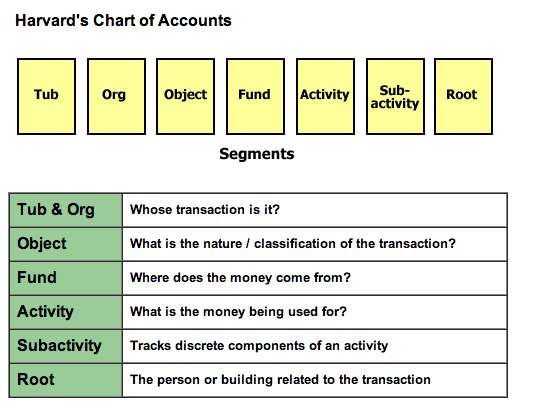Harvard's Chart of Accounts
When a sponsored award is received and accepted by the Principal Investigator and the University, an account for the award must be established in order to post expenses and income against the award. This account is a 33-digit account code that follows the Chart of Accounts (CoA) format, which is comprised of 7 Segments (Tub, Org, Object, Fund, Activity, Subactivity, and Root) that are used to transact in the Harvard financial systems.
Harvard University's Chart of Accounts (CoA) provides the organizing framework for budgeting, recording, and reporting on all University financial transactions. The Sponsored CoA Business Rules provides the rules and guidance needed to establish an account string to be used to represent the transactions of a sponsored award in the Harvard General Ledger.
33-Digit Account Code Overview
The 33-digit account code is comprised of a unique combination of fund, activity, and sub-activity values that captures the financial data of a particular award. The tub, org and root values are also important values since they identify who is responsible for an award or who is authorized to transact against the accounts of an award. The object code segment of the CoA identifies the nature of a transaction; e.g., expenses such as supplies or salaries, income, etc. Together, the tub, org, fund, activity, sub-activity, root values are the chart segment values of a 33-digit account string.
Chart of Accounts Validator
The Chart of Accounts Validator is a tool used to look-up and validate 33-digit account codes. Note: Login requires a HarvardKey and pop-up blocker must be disabled to see content.
Cross Validation Rules (CVRs)
Cross-validation rules (CVRs) are used within the Harvard General Ledger (GL) to prevent the creation of invalid GL accounts. Each cross-validation rule specifies ranges of values that are permissible to use together, and ranges that are not permissible to use together. For example, a rule might specify that only Org values 23200 through 24499 may be used with Tub 275 (HSPH). Use the chart of accounts validator tool to check for errors.
Rules are defined system wide and apply to all system users. Whenever any component of the Oracle Applications attempts to create a new 33-digit value (a combination of segment values that has not previously been used), Oracle checks all the cross-validation rules to ensure that the combination is valid. If the combination fails to pass any rule, the error message associated with that rule is presented. The transaction in process is not allowed to continue until it has a valid 33-digit combination. When there is a valid reason for an exception to the CVR, the rules may be "relaxed."
Example of when to "relax" CVRs:
An award is issued to Harvard University and both Harvard Chan School (HSPH) and Harvard Medical School (HMS) will work on a portion of the project. One school "owns" the award, in this case it is HSPH. The Main account is created with an HSPH Tub and Org as follows: M 275-45300-123456-376612-0001-66498 (Root of HSPH PI). An account is also requested for the HMS portion as a Part-of account: P 520-46530-123456-376612-0001-65007 (Root of HMS PI).
Note: The owning Tub (HSPH) must notify the school's (HMS) local chart administrator to "relax" their CVRs. You can locate the local chart administrator by selecting the Organization tab from the GMAS homepage. Enter the school org value in the search field (of the part of account) and from there, the local chart administrator email address will populate. The Local chart administrator will request cross validation rules to be relaxed by Client Services/HUIT.
Disabling Sponsored Chart of Account Values
The disabling of sponsored accounts helps to ensure awards are closed out on a timely basis and prevents additional transactions from being posted to sponsored accounts that have ended. OSP Research Finance oversees the various stages of disabling that occur. The disabling process begins with the entry of the Final Figure in GMAS and continues with the disabling of the subactivity, segment, and ultimately the fund. Note: activity values are not currently disabled in the general ledger (GL).
Role of Applications Administration
In association with the General Accounting office and the local chart administrators designated by each tub, Applications Administration manages all aspects of chart of accounts maintenance for Harvard.
Services include:
- Oversight for the integrity of the the ranges of values as they have been assigned to each tub, the values themselves and the attributes associated with them.
- Process requests to maintain (add, modify, disable or re-enable) CoA values and 33-digit combinations (CCIDs) directly in the Oracle applications or through tub requests submitted via the Chart-Security Maintenance Application (CSMA).
- Documentation, training, and support to local chart administrators and central administrative units on the creation and use of CoA values, their attributes, and the CCIDs in which they appear.
